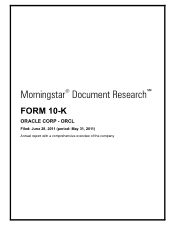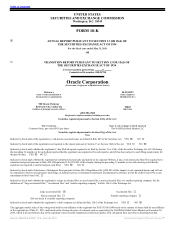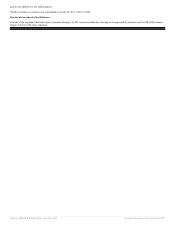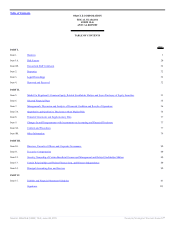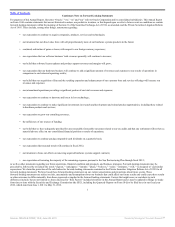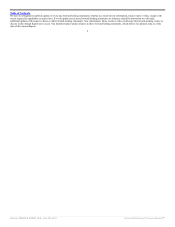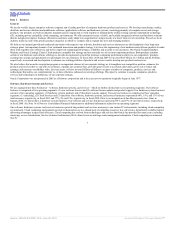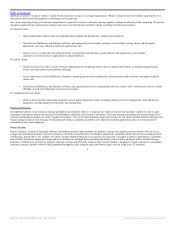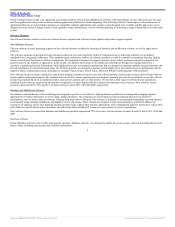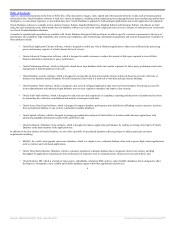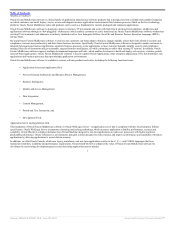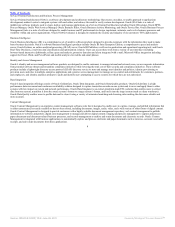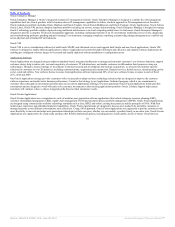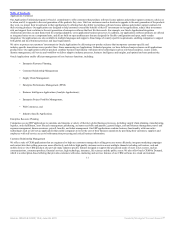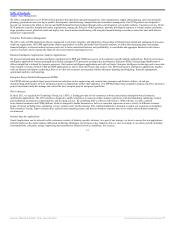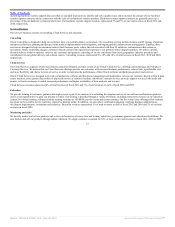Oracle 2010 Annual Report Download - page 10
Download and view the complete annual report
Please find page 10 of the 2010 Oracle annual report below. You can navigate through the pages in the report by either clicking on the pages listed below, or by using the keyword search tool below to find specific information within the annual report.
Table of Contents
analytics, and unstructured data in the form of XML files, office documents, images, video, spatial and other specialized forms of data such as human genomic
and medical data. Oracle Database software is used for a variety of purposes, including online transaction processing applications, data warehousing and business
intelligence, as a document repository or specialized data store. Oracle Database is popular for both packaged applications and custom application development.
Oracle Database software is available in four editions: Express Edition, Standard Edition One, Standard Edition and Enterprise Edition. All editions are built
using the same underlying code, which means that our database software can scale from small, single processor servers to clusters of multi-processor servers and
our Oracle Exadata Database Machines.
A number of optional add-on products are available with Oracle Database Enterprise Edition software to address specific customer requirements in the areas of
performance and scalability, high availability, data security and compliance, data warehousing, information management and systems management. Examples of
these products include:
• Oracle Real Application Clusters software, which is designed to enable any Oracle Database application to share more efficiently the processing
power and memory capacity of a fault tolerant cluster of servers;
• Oracle Advanced Compression software, which is designed to enable customers to reduce the amount of disk space required to store all their
business information and improve query performance;
• Oracle Partitioning software, which is designed to break down large database tables into smaller segments for faster query performance and easier
management of data throughout its lifecycle;
• Oracle Database security software, which is designed to encrypt data on disk and networks (Oracle Advanced Security), provide a first line of
defense from database attacks (Database Firewall) and protect data when it is archived to both disk and tape (Secure Backup);
• Oracle Database Vault software, which is designed to pro-actively safeguard application data stored in Oracle Database from being accessed by
system administrators and other privileged database users to meet regulatory mandates and improve data security;
• Oracle Audit Vault software, which is designed to reduce the cost and complexity of compliance reporting and detection of unauthorized activities
by automating the collection, consolidation and analysis of enterprise audit data;
• Oracle Active Data Guard software, which is designed to improve database performance and reliability by offloading resource-intensive activities
from a production database to one or more synchronized standby databases;
• Oracle Spatial software, which is designed to manage geospatial data and provide the facilities to location enable business applications with
advanced geographic information system (GIS) capabilities; and
• Oracle In-Memory Database Cache software, which is designed to improve application performance by caching or storing critical parts of Oracle
Database in the main memory of the application tier.
In addition to the four editions of Oracle Database, we also offer a portfolio of specialized database software products to address particular customer
requirements including:
• MySQL, the world’s most popular open source database, which is a simple-to-use, relational database often used to power high volume applications
such as websites and web-based applications;
• Oracle TimesTen In-Memory Database, which is a memory-optimized, relational database that is designed to deliver low latency and high
throughput for applications requiring real-time performance in industries such as communications, financial services and defense; and
• Oracle Berkeley DB, which is a family of open source; embeddable; relational, XML and key-value (NoSQL) databases that is designed to allow
developers to incorporate a fast, scalable and reliable database engine within their applications and devices.
6
Source: ORACLE CORP, 10-K, June 28, 2011 Powered by Morningstar® Document Research℠

